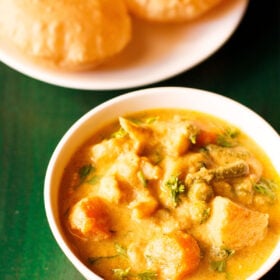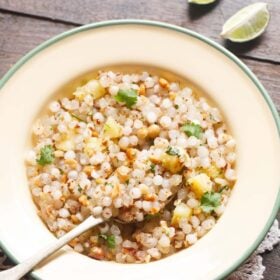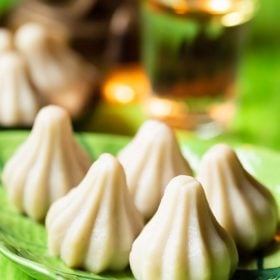Veg Kolhapuri is a delicious spicy mixed vegetables dish which has its origin in Kolhapur, a historical city in south-west Maharashtra. Kolhapuri food takes pride in being a robust cuisine and is particularly known for its hot and pungent flavors. However, not every dish in Kolhapuri cuisine is fiery. Just like in this Veg Kolhapuri recipe where I have kept the spice levels not high, but moderate. Try it to know.

My Tryst with Kolhapuri Cuisine
I’ve been to Kolhapur many times and have got the opportunity to savor vegetarian Kolhapuri cuisine in all its authenticity.
I’ve tried dishes ranging from their celebrated thalis, the spicy Vada Pav & Appe on the roadside to chilli pitla (a hot gram flour-based dish) and the Kolhapuri Misal Pav (sprouted moth beans curry), which is known to make one sweat because of its fieriness. Even the Kolhapuri dal is bold and spicy.
On my trip to Kolhapur last time, I also got my hands on the earthy Kolhapuri kanda-lasun masala (onion-garlic spice blend). This spice blend in particular is so good that it perks up the flavor of any dish it is added to.
I have used it in many of my vegetable and lentil recipes. The result of which has always been more and more praises!
Table of Contents
While in Kolhapur, I never came across the Veg Kolhapuri dish, at least in the restaurants and hotels that we went to and stayed in. Though, I have seen Veg Kolhapuri in the menu of many restaurants across India.
About Veg Kolhapuri Recipe
This Veg Kolhapuri recipe is inspired from one of the most loved and spicy dishes from Kolhapuri cuisine, the ‘Tambda Rassa.’
‘Tambda’ means ‘red’ and ‘rassa’ is a ‘thin curry or gravy.’ This famous dish is traditionally a non-vegetarian preparation which makes use of the robust Kolhapuri masala.
The Kolhapuri Masala is made with many fragrant spices together with sesame seeds, poppy seeds, dry coconut shreds and dried red chillies.
One of the main ingredients in an original Kolhapuri masala are a special type of small, but extremely hot chili called the ‘lavangi mirchi.’
For this Veg Kolhapuri recipe, which is vegan too, I have toned down the spiciness by not using the lavangi chilli.
Instead, I have added ‘Byadagi chillies’ (also known as bedgi chilli), which impart a deep color and are medium- hot. You can also use Kashmiri red chillies for a less spicy curry.
The heat levels in this Veg Kolhapuri recipe can be tolerated by most Indians. But if you do not prefer spicy pungent food, then you can cut down on the quantity of dried red chilies, ginger and garlic.
This Veg Kolhapuri uses a Kolhapuri masala, which is freshly made at home. So, you don’t need to rush to a store to get a packet. Though, if you have it, you can use it.
The quantity is mentioned in the notes’ section of recipe details. I have made the Kolhapuri masala by referring to some of the cookbooks I purchased from Kolhapur.
You can add any vegetable of your choice in this Veg Kolhapuri recipe. It is best served with chapati, phulka, paratha, bajra or jowar bhakri or steamed rice. I’ve even tried it with bread and loved it.
You can also check another less spicy dish called Paneer Kolhapuri, which is adapted from this recipe.
How to make Veg Kolhapuri
Preparation
1. Firstly, rinse, peel and cut the vegetables into thick strips or batons. Place them in a steamer pan.
I have used the following vegetables:
- 1 medium size potato
- 8 to 10 French beans
- ⅓ cup cup chopped cauliflower florets, optional
- 1 medium carrot or 2 small carrots
- ⅓ cup green peas, fresh or frozen
- 1 medium yellow/red bell pepper or green capsicum – I have sautéed the capsicum instead of steaming it.
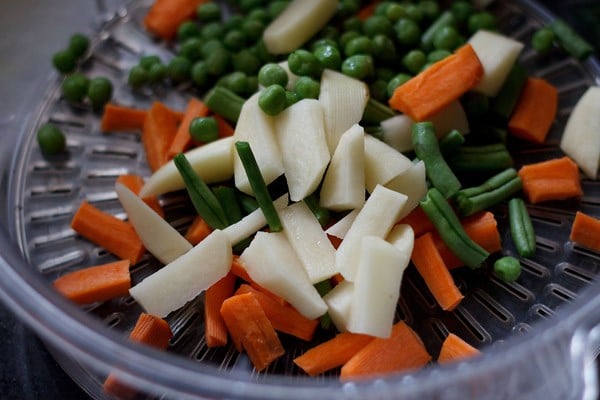
2. Then steam the vegetables in an electric cooker, steamer or a stovetop pressure cooker using water as required.
For cooking in a stovetop pressure cooker, use a 3 litre cooker. Place a trivet in the cooker. Add 2 cups of water. Place a pan containing the veggies on the trivet in the cooker.
Pressure cook for 2 to 3 whistles until the vegetables are steamed well and fork tender. Let the pressure drop naturally and then only open the lid. Drain any water from the pan and set the steamed veggies aside.
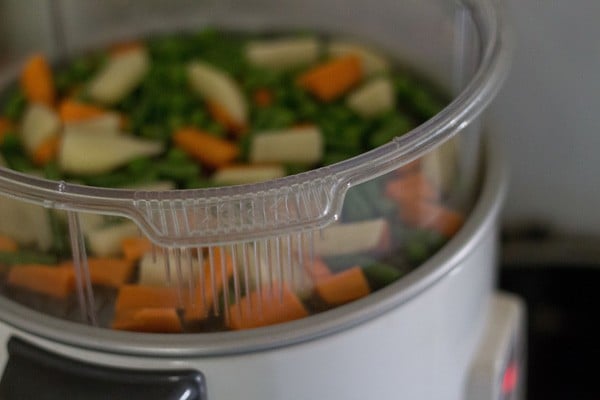
3. The vegetables have to be completely cooked and yet retain their shape.
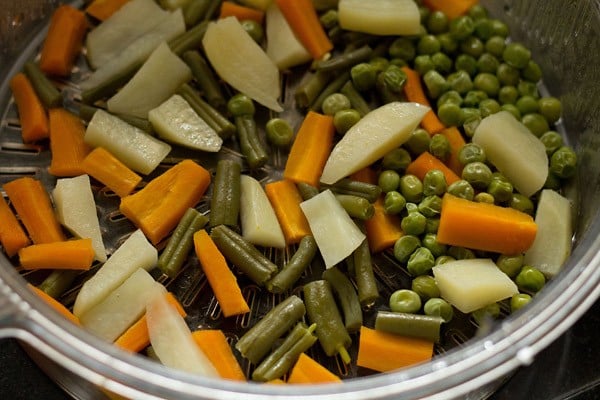
4. While the vegetables are steaming, gather all the ingredients required for making Kolhapuri masala. Below picture lists all the ingredients.
Note: If stone flower (patthar phool), cobra saffron (nagkesar) and poppy seeds (khus khus) are not available in your country, you can skip using them.
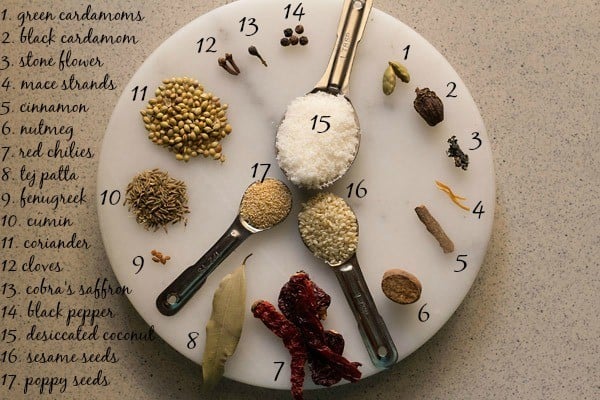
Make Kolhapuri Masala
5. Heat a pan and dry roast the below ingredients on low heat, for Kolhapuri masala first:
- 1 inch cinnamon
- 2 cloves
- 4 to 5 black peppercorns
- 1 teaspoon coriander seeds
- ½ teaspoon cumin seeds
- 4 to 5 fenugreek seeds
- 1 small stone flower (dagad phool, pathar ke phool)
- 3 dried red chilies
- 1 medium tej patta
- 1 cobra saffron (nagkesar)
- 2 single strands of mace
- 1 pinch grated nutmeg
- 1 green cardamom
- Seeds of 1 black cardamom
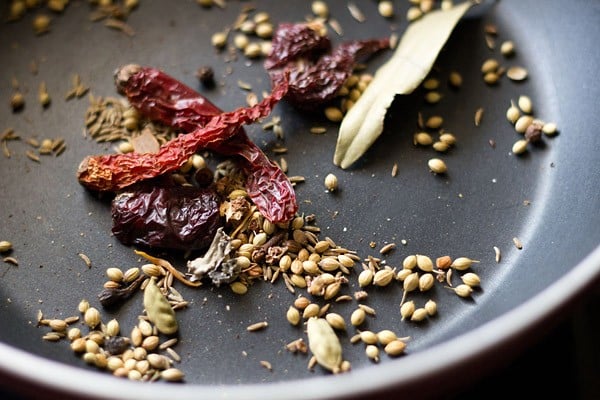
6. Once the spices become fragrant and are lightly roasted, add ½ teaspoon poppy seeds, 1 teaspoon white sesame seeds and 2 tablespoons desiccated coconut.
Here I have used grated desiccated coconut, but you can also use kopra or dried coconut. If you both are unavailable to you, add fresh or frozen coconut.
Ensure not to burn the spices; so do keep stirring often while you roast them.
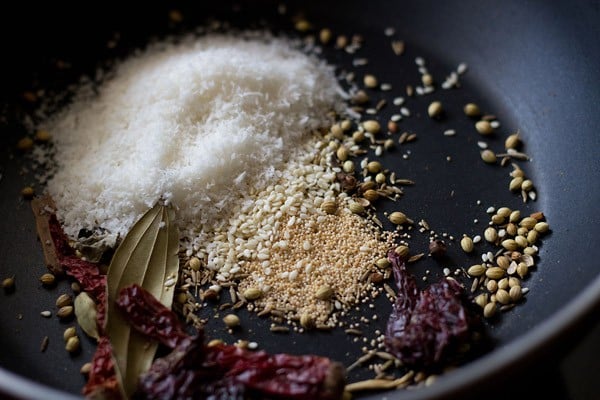
7. Stir continuously and dry roast till the coconut turns golden. Turn off the heat and set aside the pan.
Stir the spice mixture a few times, after you set aside the pan, so that the residue heat does not brown the coconut too much.

8. Once the spice mixture cools, then take them in a dry grinder or coffee grinder.
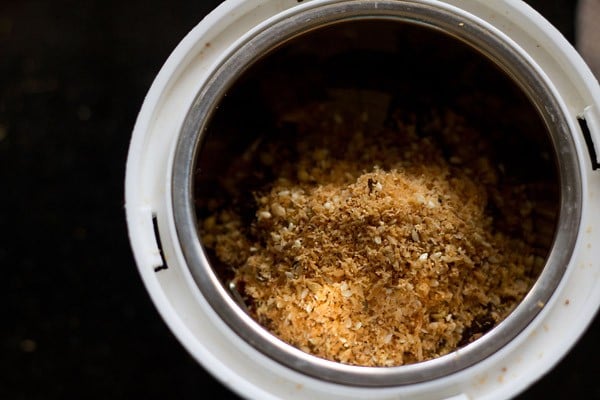
9. Grind to a fine powder. A slight semi fine powder is also fine. The sesame seeds and coconut will release oil while grinding.
Make sure to keep scraping the sides of the jar and grind. If you are finding it difficult to grind, add some water to make a fine paste.
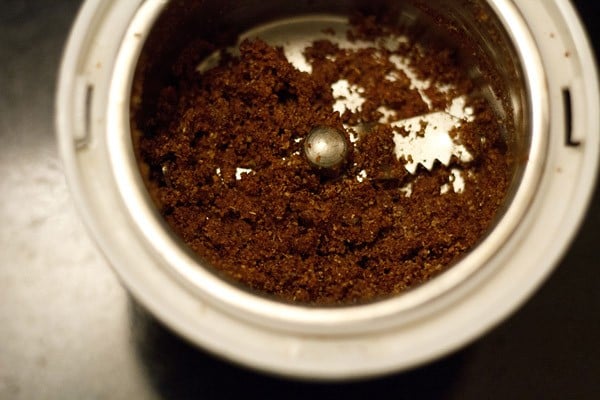
Make Veg Kolhapuri
10. Heat 2 to 2½ tablespoons oil in a pan and add ½ cup finely chopped onions.
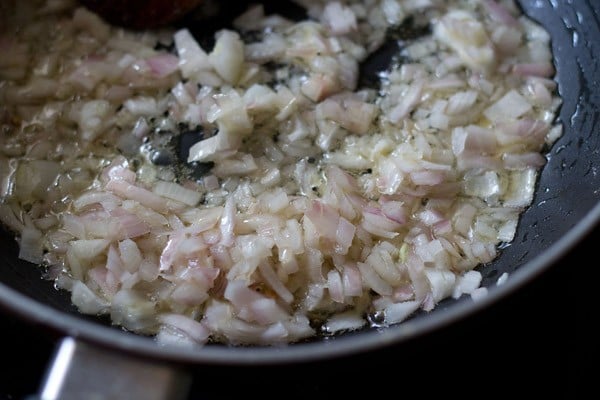
11. Sauté the onions stirring often, till they turn light golden or golden.
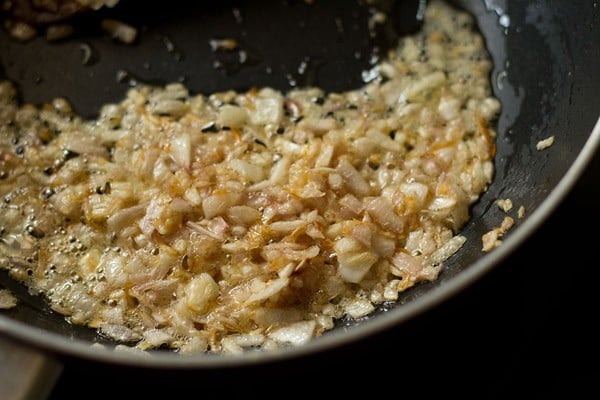
12. Add ¾ tablespoon tablespoon ginger-garlic paste.
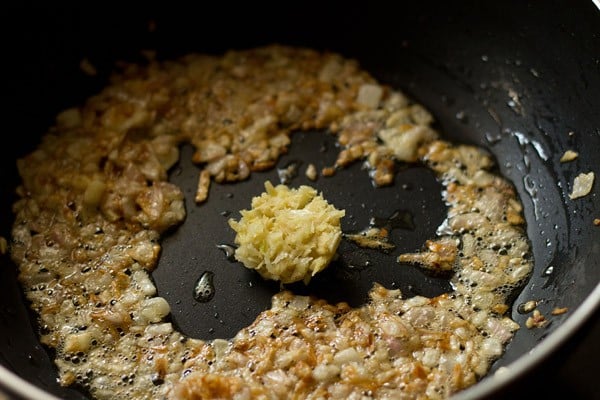
13. Stir and then add 1 tablespoon chopped coriander leaves. Stir and sauté for some seconds till the raw aroma of the ginger-garlic goes away.

14. Next, add ⅓ to ½ cup finely chopped tomatoes. Sauté till the tomatoes soften and you see oil leaving the sides of the pan.
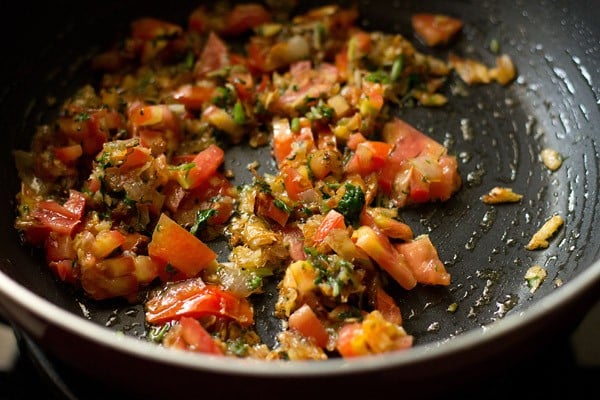
15. Add ¼ teaspoon turmeric powder, ½ teaspoon red chilli powder and 1 pinch asafoetida.
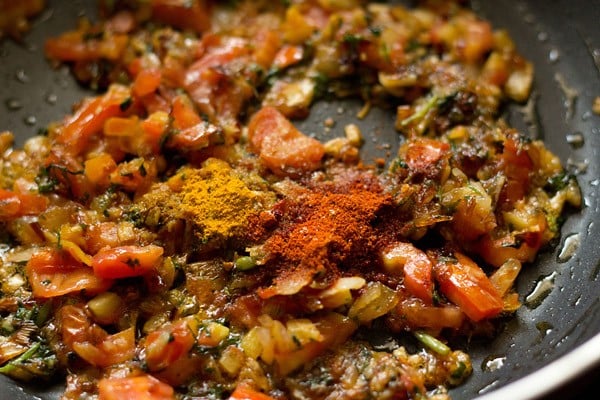
16. Stir and then add chopped bell pepper/capsicum. You can also skip capsicum if you prefer.
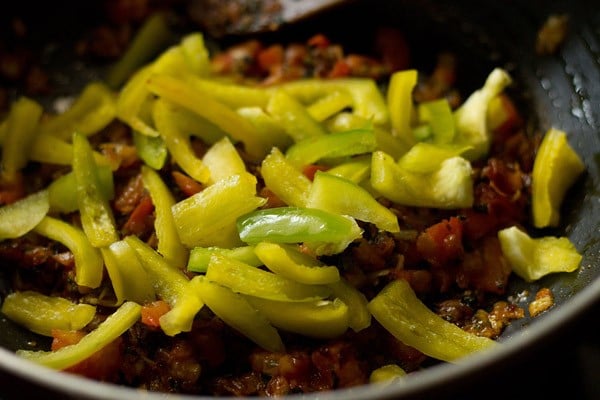
17. Stir and sauté till the bell pepper/capsicum is just about cooked and yet have a slight crunch, for about 5 to 6 minutes on low heat.
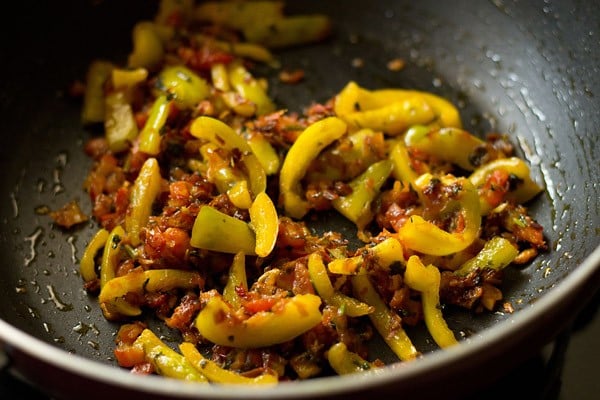
18. Add the prepared Kolhapuri masala.

19. Stir and then add 1 to 1.25 cups water. Season with salt according to taste. For a thicker curry, add less water.
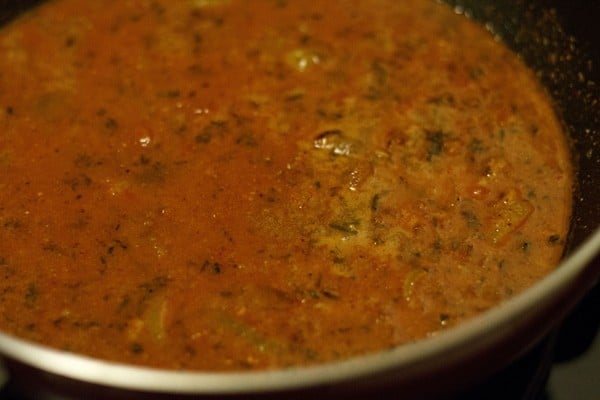
20. Bring the curry to a simmer.
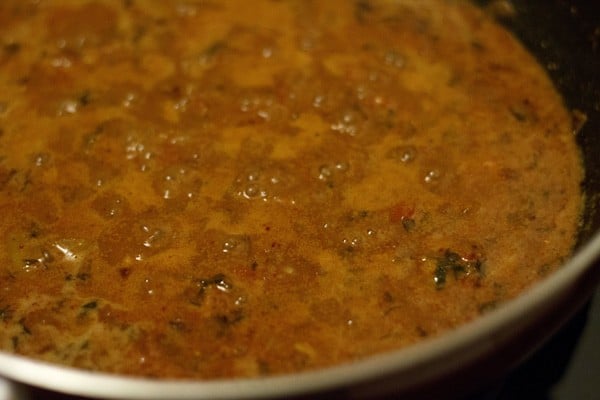
21. When you see some oil floating on top of the curry, add the steamed cooked vegetables

22. Stir and simmer for 2 minutes. The consistency of the curry is slightly thin.
Check the taste and add more salt if needed. If there is less salt, the flavor and taste of the spices do not come through.
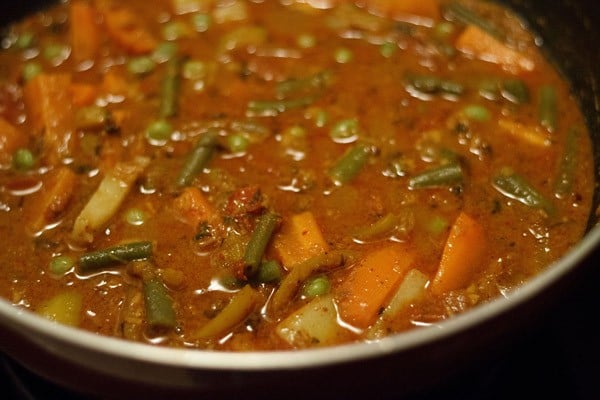
23. Lastly, add some chopped coriander leaves and give a final stir. You can also garnish with 1 to 2 tablespoons of chopped coriander leaves.

24. Serve Vegetable Kolhapuri with soft phulka, chapati, parathas or bhakri. You can also serve this spicy curry with bread, dinner rolls (pav) or steamed rice.
Any leftover curry keeps well in the refrigerator for about a day. While reheating add some water if the curry consistency has thickened.
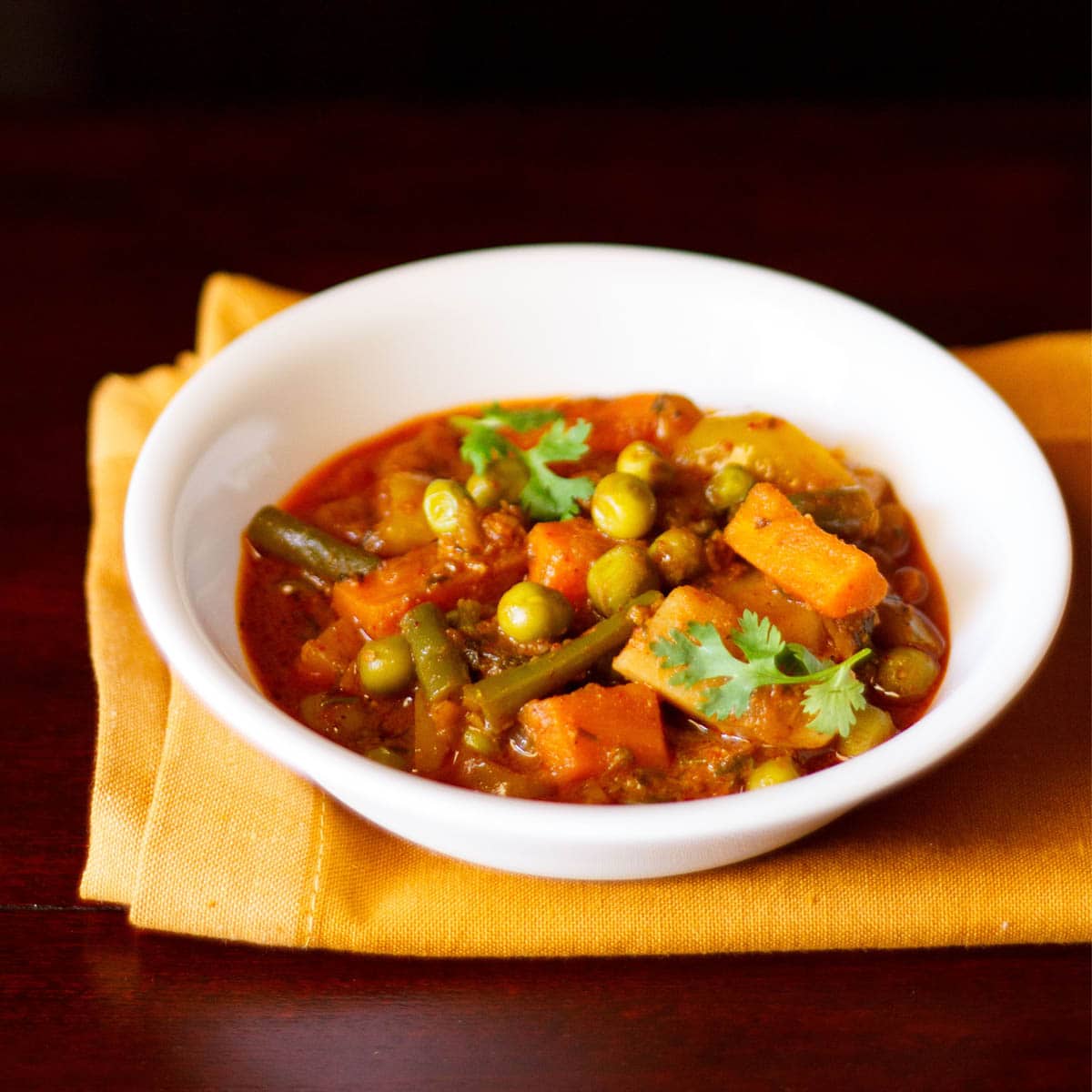
Places to visit in Kolhapur
Due to its rich spiritual history, Kolhapur is also known as ‘Kashi of South’ or ‘Dakshin Kashi.’ So, whenever you visit Kolhapur, make sure to visit the most revered Mahalakshmi Temple. It is one of the ‘Shakti Peethas’ in Maharashtra.
Other places of interest include Siddhagiri or Kaneri Math, Kopeshwar Shiva Temple, Narsobawadi (a Lord Dattatreya temple on the confluence of rivers Krishna and Panchganga), Jyotiba Temple and the freshwater Rankala Lake.
Expert Tips
- The elements of heat and pungency in this Veg Kolhapuri can be increased or decreased depending on the type and quantity of red chili added to the curry.
- Any vegetables of your choice can be added to this curried dish. The vegetables should be fork tender, yet keep their shape. Ensure not to overcook the veggies.
- While grinding the spices for Kolhapuri masala, the sesame seeds and coconut will release oil. Make sure to keep scraping the sides of the grinder jar and grind further. If you are finding it difficult to grind, add some water to make a fine paste.
- Make sure to use the best quality spices, including good quality sesame and poppy seeds, ones which are within their shelf-life and fresh. If you fail to do so, you might end up having a slight bitter taste in your Vegetable Kolhapuri.
- In case you don’t have stone flower, cobra saffron or poppy seeds, you can skip using them.
- If you have readymade Kolhapuri kanda-lasun masala or the Kolhapuri masala, then add about 2 to 2½ tablespoons of it.
FAQs
Yes it can contain paneer together with the mixed vegetables. You can add paneer cubes, squares and even garnish your Veg Kolhapuri with grated paneer.
Yes, you can use black poppy seeds. But the color of the gravy will change in this case.
Goda masala is different from Kolhapuri masala in terms of flavor and aroma. Goda masala is actually a no onion, no garlic masala with sweet tones whereas Kolhapuri masala has onion and garlic and is pungent and spicy.
Since I have not added onion and garlic in the recipe of the Kolhapuri masala powder and added them to the curry, you can use goda masala in the recipe. But make a note that your curry will be a medium-spiced Maharashtrian style mix veg curry variant and not Vegetable Kolhapuri.
Yes, you can prepare the dry spices beforehand and store the roasted dry spices in the refrigerator for about a week.
You can skip the preparation of the Kolhapuri masala and just add 2 to 2½ tablespoons of the readymade/store-bought Kolhapuri kanda-lasun masala in this Vegetable Kolhapuri.
More Veg Curry Recipes To Try
Indian Curry Recipes
Indian Curry Recipes
Gluten Free Recipes
South Indian Food Recipes
Please be sure to rate the recipe in the recipe card or leave a comment below if you have made it. For more vegetarian inspirations, Sign Up for my emails or follow me on Instagram, Youtube, Facebook, Pinterest or Twitter.
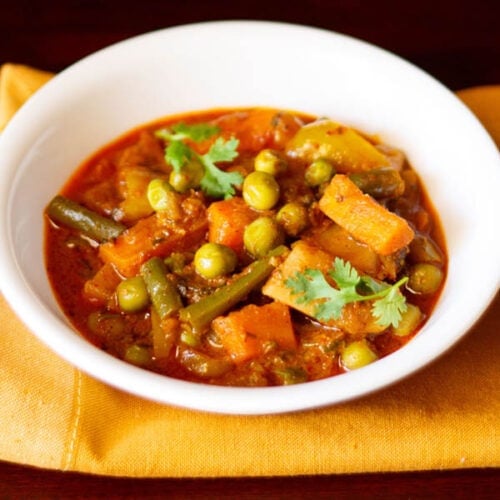
Veg Kolhapuri Recipe
Ingredients
For Kolhapuri Masala
- 1 teaspoon white sesame seeds (safed til)
- ½ teaspoon poppy seeds (khus khus)
- 2 tablespoon desiccated coconut
- 4 to 5 black peppercorns
- 1 teaspoon coriander seeds
- ½ teaspoon cumin seeds
- 1 inch cinnamon
- 2 cloves
- 2 single strands of mace (javitri)
- 4 to 5 fenugreek seeds (methi dana)
- 1 pinch grated nutmeg (jaiphal)
- 1 small stone flower (patthar phool or dagad phool) – optional
- 1 cobra saffron (nagkesar) – optional
- 1 green cardamom
- 1 black cardamom – seeds kept and husks discarded
- 3 dried red chilies byadgi/bedgi or Kashmiri red chilies, seeds removed
- 1 tej patta
Vegetables (To be cooked separately in a pan, steamer or pressure cooker)
- ½ cup potato – chopped in sticks or batons or 1 medium size potato
- ¼ cup French beans – chopped in batons, or 8 to 10 French beans
- ⅓ cup cauliflower – chopped, optional
- ⅓ cup carrot – chopped in sticks or batons, about 2 small carrots or 1 medium carrot
- ⅓ cup green peas – fresh or frozen
- 2 cups water – for steaming vegetables in a stovetop pressure cooker or a pan/pot.
More Ingredients
- 2 to 2.5 tablespoons oil – peanut or sunflower oil
- ½ cup onion finely chopped or 1 medium-sized
- 1 tablespoon ginger-garlic paste or 5 to 6 small to medium garlic cloves + 1 inch ginger crushed to paste in a mortar
- 1 tablespoon coriander leaves (cilantro), chopped
- ⅓ to ½ cup tomato – finely chopped or 1 medium-sized
- ¼ teaspoon turmeric powder
- ½ teaspoon red chilli powder
- 1 pinch asafoetida (hing)
- ⅓ cup bell pepper – sliced, about 1 medium green or red or yellow bell pepper, optional
- 1 to 1.25 cups water or add as required
- salt as required
- 1 to 2 tablespoon coriander leaves – for garnish
Instructions
Preparation
- First, rinse, peel and cut the vegetables into thick strips or batons. Place them in a steamer pan.
- Then steam the vegetables in an electric cooker, steamer or stovetop pressure cooker, adding water as needed for steaming.
- For steaming veggies in a stovetop pressure cooker, use a 3 litre cooker. Place a trivet in the cooker.
- Add 2 cups of water. Place a pan containing the chopped veggies on the trivet in the cooker.
- Pressure cook for 2 to 3 whistles until the vegetables are steamed well and fork tender. Let the pressure drop naturally and then only open the lid. Drain any water from the pan and set the steamed veggies aside.
- The vegetables have to be completely cooked and yet retain their shape.
- While the vegetables are steaming, gather all the ingredients required for making Kolhapuri masala.
Making kolhapuri masala
- Heat a pan on low heat and dry roast the spices on low heat – cinnamon, cloves, black pepper, coriander seeds, cumin seeds, fenugreek seeds, stone flower, mace strands, pinch of nutmeg powder, bay leaf, cobra saffron, red chilies, green cardamoms and black cardamom seeds.
- Skip stone flower, cobra saffron and poppy seeds, if you don't have these.
- Once the spices become fragrant and lightly roasted, add poppy seeds, sesame seeds and desiccated coconut.
- Stir continuously and dry roast till the desiccated coconut turns golden. Take care not to burn any of the ingredients.
- Turn off the heat and set aside the pan.
- Stir the spice mixture a few times, after you set aside the pan, so that the residue heat does not brown the coconut too much. Or you can transfer the roasted spice mix onto a plate.
- Once the spice mixture cools, take them in a dry grinder or coffee grinder.
- Grind to a fine powder. A slight semi fine powder is also fine. The sesame seeds and coconut will release oil while grinding.
- Make sure to keep scraping the sides of the grinder jar and grind further. If you are finding it difficult to grind, add some water to make a fine paste.
Making veg kolhapuri
- Heat oil in a pan and add chopped onions.
- Sauté the onions stirring often until they turn light golden or golden.
- Add ginger-garlic paste.
- Stir and then add chopped coriander leaves. Stir and sauté for some seconds, till the raw aroma of the ginger-garlic goes away.
- Next, add chopped tomatoes.
- Sauté till the tomatoes soften and you see oil leaving the sides of the pan.
- Add turmeric powder, red chili powder and asafoetida.
- Stir and then add chopped bell pepper/capsicum. You can also skip capsicum if you prefer.
- Stir and sauté till the bell pepper is half cooked and yet have a slight crunch. About 5 to 6 minutes on a low heat.
- Add the ground Kolhapuri masala.
- Stir and sauté for a few seconds.
- Then add water. Season with salt as per taste.
- Bring the curry to a simmer.
- When you see some oil floating on top of the curry or gravy, add the steamed vegetables.
- Stir and simmer the gravy for about 2 minutes.
- Lastly, add chopped coriander leaves and give a final stir. You can also garnish with the coriander leaves.
- Serve Veg Kolhapuri hot with soft chapati, phulka or paratha. You can also serve this spicy vegetable curry with bread and steamed rice.
Notes
- If you have readymade Kolhapuri kanda-lasun masala or the Kolhapuri masala, then add about 2 to 2½ tablespoons of it.
- The elements of heat and pungency in this Veg Kolhapuri can be increased or decreased depending on the type of red chili you add.
- Any vegetables of your choice can be added to this spicy curry. The vegetables should be cooked completely, yet retain their shape.
- The veggies can be steamed in a pan or pot or in a stovetop pressure cooker. You can also choose to steam vegetables in an Instant Pot or an electric pressure cooker if you have one. Add water as needed, depending on the size of your pan or equipment used.
- In case you don’t have stone flower, cobra saffron or poppy seeds, you can skip using them.
- Desiccated coconut can be swapped with dry coconut or copra. If out of desiccated coconut or dry coconut, you can opt to use frozen or fresh coconut.
- The curry consistency can be adjusted by adding less or more water.
- You can also add some paneer cubes to the curry if you prefer.
Nutrition Info (Approximate Values)
This Veg Kolhapuri recipe from the blog archives first published in November 2014 has been updated and republished on October 2023.



